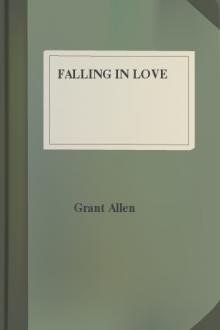Falling in Love by Grant Allen (different e readers .txt) 📕

- Author: Grant Allen
- Performer: -
Book online «Falling in Love by Grant Allen (different e readers .txt) 📕». Author Grant Allen
And this leads us on to consider what in reality hibernation is. Everybody knows nowadays, I suppose, that there is a very close analogy between an animal and a steam-engine. Food is the fuel that makes the animal engine go; and this food acts almost exactly as coal does in the artificial machine. But coal alone will not drive an engine; a free draught of open air is also required in order to produce combustion. Just in like manner the food we eat cannot be utilised to drive our muscles and other organs unless it is supplied with oxygen from the air to burn it slowly inside our bodies. This oxygen is taken into the system, in all higher animals, by means of lungs or gills. Now, when we are working at all hard, we require a great deal of oxygen, as most of us have familiarly discovered (especially if we are somewhat stout) in the act of climbing hills or running to catch a train. But when we are doing very little work indeed, as in our sleeping hours, during which muscular movement is suspended, and only the general organic life continues, we breathe much more slowly and at longer intervals. However, there is this important difference (generally speaking) between an animal and a steam-engine. You can let the engine run short of coals and come to a dead standstill, without impairing its future possibilities of similar motion; you have only to get fresh coals, after weeks or months of inaction, and light up a fresh fire, when your engine will immediately begin to work again, exactly the same as before. But if an animal organism once fairly runs down, either from want of food or any other cause—in short, if it dies—it very seldom comes to life again.
I say 'very seldom' on purpose, because there are a few cases among the extreme lower animals where a water-haunting creature can be taken out of the water and can be thoroughly dried and desiccated, or even kept for an apparently unlimited period wrapped up in paper or on the slide of a microscope; and yet, the moment a drop of water is placed on top of it, it begins to move and live again exactly as before. This sort of thorough-going suspended animation is the kind we ought to expect from any well-constituted and proper-minded toad-in-a-hole. Whether anything like it ever really occurs in the higher ranks of animal life, however, is a different question; but there can be no doubt that to some slight extent a body to all intents and purposes quite dead (physically speaking) by long immersion in water—a drowned man, for example—may really be resuscitated by heat and stimulants, applied immediately, provided no part of the working organism has been seriously injured or decomposed. Such people may be said to be pro tem. functionally, though not structurally, dead. The heart has practically ceased to beat, the lungs have ceased to breathe, and physical life in the body is temporarily extinct. The fire, in short, has gone out. But if only it can be lighted again before any serious change in the system takes place, all may still go on precisely as of old.
Many animals, however, find it convenient to assume a state of less complete suspended animation during certain special periods of the year, according to the circumstances of their peculiar climate and mode of life. Among the very highest animals, the most familiar example of this sort of semi-torpidity is to be found among the bears and the dormice. The common European brown bear is a carnivore by descent, who has become a vegetarian in practice, though whether from conscientious scruples or mere practical considerations of expediency, does not appear. He feeds chiefly on roots, berries, fruits, vegetables, and honey, all of which he finds it comparatively difficult to procure during winter weather. Accordingly, as everyone knows, he eats immoderately in the summer season, till he has grown fat enough to supply bear's grease to all Christendom. Then he hunts himself out a hollow tree or rock-shelter, curls himself up quietly to sleep, and snores away the whole livelong winter. During this period of hibernation, the action of the heart is reduced to a minimum, and the bear breathes but very slowly. Still, he does breathe, and his heart does beat; and in performing those indispensable functions, all his store of accumulated fat is gradually used up, so that he wakes in spring as thin as a lath and as hungry as a hunter. The machine has been working at very low pressure all the winter: but it has been working for all that, and the continuity of its action has never once for a moment been interrupted. This is the central principle of all hibernation; it consists essentially of a very long and profound sleep, during which all muscular motion, except that of the heart and lungs, is completely suspended, while even these last are reduced to the very smallest amount compatible with the final restoration of full animal activity.
Thus, even among warm-blooded animals like the bears and dormice, hibernation actually occurs to a very considerable degree; but it is far more common and more complete among cold-blooded creatures, whose bodies do not need to be kept heated to the same degree, and with whom, accordingly, hibernation becomes almost a complete torpor, the breathing and the action of the heart being still further reduced to very nearly zero. Mollusks in particular, like oysters and mussels, lead very monotonous and uneventful lives, only varied as a rule by the welcome change of being cut out of their shells and eaten alive; and their powers of living without food under adverse circumstances are really very remarkable. Freshwater snails and mussels, in cold weather, bury themselves in the mud of ponds or rivers; and land-snails hide themselves in the ground or under moss and leaves. The heart then ceases perceptibly to beat, but respiration continues in a very faint degree. The common garden snail closes the mouth of his shell when he wants to hibernate, with a slimy covering; but he leaves a very small hole in it somewhere, so as to allow a little air to get in, and keep up his breathing to a slight amount. My experience has been, however, that a great many snails go to sleep in this way, and never wake up again. Either they get frozen to death, or else the respiration falls so low that it never picks itself up properly when spring returns. In warm climates, it is during the summer that mollusks and other mud-haunting creatures go to sleep; and when they get well plastered round with clay, they almost approach in tenacity of life the mildest recorded specimens of the toad-in-a-hole.
For example, take the following cases, which I extract, with needful simplifications, from Dr. Woodward.
'In June 1850, a living pond mussel, which had been more than a year out of water, was sent to Mr. Gray, from Australia. The big pond snails of the tropics have been found alive in logs of mahogany imported from Honduras; and M. Caillaud carried some from Egypt to Paris, packed in sawdust. Indeed, it isn't easy to ascertain the limit of their endurance; for Mr. Laidlay, having placed a number in a drawer for this very purpose, found them alive after five years' torpidity, although in the warm climate of Calcutta. The pretty snails called cyclostomas, which have a lid to their shells, are well known to survive imprisonments of many months; but in the ordinary open-mouthed land-snails such cases are even more remarkable. Several of the enormous tropical snails often used to decorate cottage mantelpieces, brought by Lieutenant Greaves from Valparaiso, revived after being packed, some for thirteen, others for twenty months. In 1849, Mr. Pickering received from Mr. Wollaston a basketful of Madeira snails (of twenty or thirty different kinds), three-fourths of which proved to be alive, after several months' confinement, including a sea voyage. Mr. Wollaston has himself recorded the fact that specimens of two Madeira snails survived a fast and imprisonment in pill-boxes of two years and a half duration, and that large numbers of a small species, brought to England at the same time, were all living after being inclosed in a dry bag for a year and a half.'
Whether the snails themselves liked their long deprivation of food and moisture we are not informed; their personal tastes and inclinations were very little consulted in the matter; but as they and their ancestors for many generations must have been accustomed to similar long fasts during tropical droughts, in all likelihood they did not much mind it.
The real question, then, about the historical toad-in-a-hole narrows itself down in the end merely to this—how long is it credible that a cold-blooded creature might sustain life in a torpid or hibernating condition, without food, and with a very small quantity of fresh air, supplied (let us say) from time to time through an almost imperceptible fissure? It is well known that reptiles and amphibians are particularly tenacious of life, and that some turtles in particular will live for months, or even for years, without tasting food. The common Greek tortoise, hawked on barrows about the streets of London and bought by a confiding British public under the mistaken impression that its chief fare consists of slugs and cockroaches (it is really far more likely to feed upon its purchaser's choicest seakale and asparagus), buries itself in the ground at the first approach of winter, and snoozes away five months of the year in a most comfortable and dignified torpidity. A snake at the Zoo has even been known to live eighteen months in a voluntary fast, refusing all the most tempting offers of birds and rabbits, merely out of pique at her forcible confinement in a strange cage. As this was a lady snake, however, it is possible that she





Comments (0)